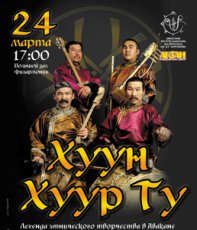|
 On 24 March, on the stage of the great hall of Khakassia republic Philharmony, there will be a concert of the legendary group Huun-Huur-Tu - the most famous ethno-ensemble in the world. On the pages of "The New York Times", the group has been described as a "musical wonder", and the "San Francisco Chronicle" called the group "magic of vocals", as the press-service of the ministry of culture of Khakassia noted. On 24 March, on the stage of the great hall of Khakassia republic Philharmony, there will be a concert of the legendary group Huun-Huur-Tu - the most famous ethno-ensemble in the world. On the pages of "The New York Times", the group has been described as a "musical wonder", and the "San Francisco Chronicle" called the group "magic of vocals", as the press-service of the ministry of culture of Khakassia noted.
Every note of this music is unique, with subtly perceptible flavor of ancient times, majesty of the mountains and serenity of the steppes. The magical sounds of ancient folk instruments such as khomus, igil, doshpuluur, shaman's drum, as well as Tuvan throat-singing "khoomei" transport the listener into the times when nature and a human being were one unbroken whole. In the West, the music of Huun-Huur-Tu has gained huge popularity. Many prominent musicians of various directions expressed a wish to co-operate with Huun-Huur-Tu. One of great admirers and propagators of Huun-Huur-Tu was Frank Zappa, who shortly before his death invited Tuvans to his home studio (1993). Music of Huun-Huur-Tu brought in many of Zappa's friends, who recorded themselves with the Tuvan musicians: The Chieftains, Johnny "Guitar" Watson, and L. Shankar. Kronos Quartet, the elite of contemporary chamber avant-garde also recorded several compositions with Huun-Huur-Tu, one of which, "Kongurei" opens Kronos Quartet's album "Night Prayers" in 1994, Kronos Quartet and Huun-Huur-Tu gave a joint concert to a packed 4-thousand place Memorial Hall of Stanford university.
Western press about Huun-Huur-Tu: "Kaigal-ool Khovalyg is the Pavarotti of throat-singing" (Newsweek); "Tuvans will ride into your brain and leave hoof-prints…" (San Francisco Bay Guardian}; "These musicians exude rustic cheer and sincere expressiveness" (Jazz Times}; 'it is unknown, and at the same time very accessible deeply spiritual music, coming from another world, with its roots in the sounds of nature" (The Chicago Tribune); "Imagine cool fresh air, where, high above sea level, there are wild steppes, stormy rivers, singing birds, fast horses, yoyrts and culture, which combines Buddhism and shamanism. Now imagine that all that is in the music. With rhythm. That is how it sounds." (Union News, Springfield).
|
|
